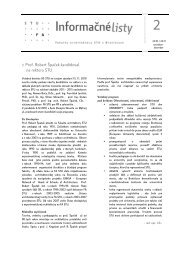ALFA 3-4/2005 - Fakulta architektúry STU
ALFA 3-4/2005 - Fakulta architektúry STU
ALFA 3-4/2005 - Fakulta architektúry STU
You also want an ePaper? Increase the reach of your titles
YUMPU automatically turns print PDFs into web optimized ePapers that Google loves.
Ročník 9<br />
3-4 / <strong>2005</strong> ARCHITEKTONICKÉ LISTY FA <strong>STU</strong><br />
Tomáš GÁL<br />
INTERIOR DESIGN – CONTEXTS OF THE 20 th<br />
The 20 th Century is the period with very strong, we could say,<br />
turbulent evolution. Technical revolution, modern technologies and<br />
new materials primarily caused this. But not only technology was<br />
the one which influenced the evulution and development – it was<br />
also dynamically alternating aesthetic values, economic prosperity<br />
and teritorial differences. Architecture and interior design surely<br />
also have taken a part on this transformation.<br />
Even if chair seems to be a common piece of everyday use,<br />
through its physical and psychological relationship to the user we<br />
can say that it has a very special position in the civilisation of man.<br />
Christopher Dresser defined basic form of a chair in 1873 as<br />
“a stool with a back-rest while stool is a board elevated from<br />
the ground by supports” (P. and Ch. Fiell, 1993). Even if this<br />
definition of the chair seems like absurdly simplistic for today, for<br />
over the last hundred years, the chair has been a subject to<br />
a succession of revolutionary transformations. It became<br />
a phenomenon of culture many times loaded with symbolic and<br />
iconological meanings. Thanks to the modern technology,<br />
the 20 th<br />
Century offers a real gallery view of seating furniture.<br />
Never before has this theme been developed in shape, plasticity,<br />
colour and material.<br />
In the 20th Century the chair has become not only ordinary<br />
consumer or useful object but also an object of important aesthetic<br />
values. As a symbolic object the chair has a lot of equals, which<br />
can express power and authority (for example throne or electric<br />
chair) or status of its user. More than any other type of furniture,<br />
the chair can be seen as a social barometer. The chair uses to<br />
mirror the social and economic contexts of the human society. In<br />
time of economic depression rationally designed and durable<br />
chairs are prefered while in periods of relative prosperity there is<br />
a general tendency to prefer more anti-rational, ornamental or<br />
extravagant forms. The proof that the chair has a special place in<br />
development of design and human society is the work of<br />
architects as well. They use to design chairs more often than other<br />
types of furniture. One of the reasons is the quest for greater unity<br />
between interior design and architecture of their buildings. Another<br />
reason is the fact that through the chair design they could more<br />
easily and quickly, than with architecture, express their design<br />
philosophy and opinion in three dimensions. Architects with their<br />
background knowledge of engineering were especially well placed<br />
to develop new furniture products and designs that were both<br />
functional and aesthetic.<br />
During the second half of the 19 th Century the chair became an<br />
industrial product. Michael Thonet and his results of the pionering<br />
research of the steam-bending of wood became revolutional for<br />
the future chair production. His company Gebrueder Thonet<br />
manufactured the first truly mass-produced chairs thanks to<br />
the newly patented technology for steam-bending. The Thonet chair<br />
- 43 -<br />
CENTURY - THE CHAIR<br />
represents a norm of modern chairs with strong influence for<br />
the 20 th Century chair design and production. It is the absolute<br />
synthesis of form and function and the perfect integration of<br />
material, technology and purpose. The proof of the real mass<br />
production is the production of 40 million chairs of the “Model<br />
No. 14” at the break of the 19 th and 20 th Century. The value of Thonet<br />
chairs was appreciated by a lot of architects during the first half of<br />
the 20 th Century who used them in their interior projects. Thonet<br />
models were produced during the whole 20 th Century and even<br />
today are being produced in modified form.

















